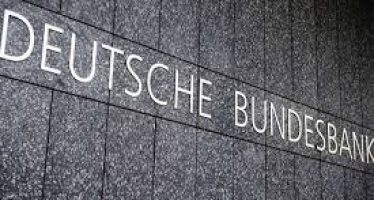IMF: Turbulence and the Lessons of History
Opportunities are born of crisis, but the lines that connect them are far from direct
Events of recent years, and most recently the COVID-19 pandemic and the war in Ukraine, have forced all of us to confront some of the hazards inherent in our interconnected world. In the 21st century, the gravest threat to international stability appears to lie in our societies’ greater interdependence, reinforcing the power of a shock from anywhere in the world to become systemic.
History counters society’s perception that the challenge presented by this increasingly interconnected world is new. In the first half of the 20th century, the world reeled from one shock to another: World War I, the Spanish flu, communist revolutions, a Great Depression characterized by rival trade blocs, and a global geopolitical crisis generated by the Axis powers that resulted in World War II.
After 1940, efforts ensued to build a new world order, centered around the United Nations (UN). Over time, the continued proliferation and specialization of multilateral organizations appeared to signal their success, and by the early 2000s the benefits of institutionalized multilateralism were self-evident and went largely uncontested.
The 21st century has put an end to the notion that international institutions can anticipate and manage shocks. Charges that the World Health Organization is partisan and that the UN has failed in its response to the war in Ukraine have spawned the revival and reassertion of Cold War battle lines, with talk of democratic versus authoritarian powers. As the world turns its gaze to Turkey and China as possible mediators to end the war, the global order established in 1945—and the liberal institutions that embody it—seems at greater risk than ever before. This comes as we face the real possibility of more shocks, which will severely threaten political stability, social cohesion, economic prospects, and the natural systems that support us.
Managing future shocks
These tribulations come after more than 20 years of challenges to the UN system. Problems with the UN organization are sometimes conflated with the operations of its many specialized agencies. These pose the risk of the UN system going the way of the League of Nations, the world’s first intergovernmental body, which was in many ways the forerunner and foundational cornerstone of the UN institutions that succeeded it. With history mobilized by actors on all sides in the Ukrainian war, are there any lessons this history of failure can teach us as we face the challenge of future shocks?
First, and most immediately, the long view of history shows us it is better not to think of periods of historical time as eras of stability or crisis, equilibrium or shock. The first half of the 20th century was not a period of unending shocks any more than the Cold War era was stable—a world order apparently determined by two superpowers, the United States and the Union of Soviet Socialist Republics, and harmoniously overseen and managed by global institutions. The US unipolar moment, which followed the end of the Cold War, similarly masked deeper complexities. A new power shift is underway, but it is not just in China’s favor. China is no more likely to be the sole dominant power in the 21st century than the United States was in the 20th century. The debate about managing future shocks needs to focus on the challenge of multipolarity and the uneven distribution of global resources and power.
It is better to anticipate the problem before us as one of managing turbulence rather than to see each shock as separate. This encourages us to avoid the dichotomy between stability and change, to confront their different chronologies, and to recognize the relationship between different types of shocks. For example, it will help us recognize that the current disruption to food and fertilizer supplies in Ukraine will have consequences that outlast the war. This is what happened after 1918, when the rapid development of overseas markets for the United States turned from boom to bust, with lasting effects on North American wheat prices that had consequences for US trade policy and diplomacy. Similarly long-lasting were the effects of population displacement after both world wars. In the decade or more after these wars ended, the West largely forgot about the large numbers of displaced central and eastern Europeans who still lived in temporary camps. The risks to European solidarity will be considerable if countries such as Poland are left to deal alone with a socioeconomic challenge that will endure for some time to come.
One of the core lessons—if not the key lesson—of the failure of international cooperation and global governance on the road to World War II was the absolute centrality of the political economy. There were persistent efforts to promote new international norms and practices that would facilitate coordination and cooperation throughout the 1920s and the 1930s among liberal democracies. This shared history—and the intelligence it generated—was the cornerstone on which a new order was built. And planning for it began as early as 1940. This should not be forgotten by 21st century diplomats, even as geopolitical issues necessarily take center stage in the short term.
Ukrainian artists are mining the history of their cultural resistance to Joseph Stalin in the late 1920s and 1930s as they resist Russian imperialism once more. It is a stark reminder that global order is not forged by political leaders from on high. The 1920s, more than any previous decade, was characterized by waves of social mobilization around international questions relating to war and peace across the political spectrum. Many of the nongovernmental organizations currently supporting displaced Ukrainian civilians grew out of local, grass-roots activism. Recent events signal a strong shift akin to that of the 1920s, with claims for justice emerging across many parts of the world, providing an opportunity to reengage public interest in international organizations (not just activism). There is now a new generation of self-starting aid entrepreneurs, who have found an authoritative voice and can help set the framework and determine the language for broader conversations about reforms needed to produce better solutions to our shared challenges.
From local to global
And what should those solutions look like? The global pandemic has underscored the significance of the local to the global. The fight against epidemics of typhus, cholera, and tuberculosis in the 1920s established international mechanisms of scientific and humanitarian collaboration that continued even as countries went to war with one another. These practices recognized the need for a global commitment to supporting local, community-based programs that includes economic and financial support as well as better health care. In 1945, this history gave rise to new institutions of global governance in the field of health and economics—the World Health Organization, the Food and Agriculture Organization, the International Monetary Fund, and the World Bank—highlighting one of many moments when the practices and institutionalization of global governance were challenged, disassembled, and reassembled in the wake of new shocks.
It is extremely difficult to create cooperative institutions of global governance from scratch. In 1945, the multipurpose League of Nations gave way to single-purpose UN institutions, suggesting that strands and forms of governance are discrete from one another—health, food, finance, trade, geopolitics, displaced peoples, climate change. Events of the past few years, and notably the COVID-19 pandemic and the war in Ukraine, make it clear that they are not. Recognizing how economic and social issues are connected should be central to future efforts to stem escalating geopolitical tensions. When planning for the future—and we need to plan—we must give just as much attention to how shocks such as population displacement, disease, geopolitical conflict, disruptive technological innovation, and climate change interact and how to effect and coordinate multiagency and state engagement. Managing these shocks cannot be left to individual institutions, such as the North Atlantic Treaty Organization (NATO) or the IMF.
Crucially, the war in Ukraine has underscored the importance of regional institutions to global governance. Decades-old, apparently moribund, questions about how NATO, the European Union, and the UN Security Council and General Assembly should relate to one another in regard to human security are now alive and kicking. If regional governance is key, the global implications of new regional institutions, such as the Asian Infrastructure Investment Bank, are far from clear. Global governance, as the history of the United Nations itself shows, is strongly path-dependent. If this presents a new reform agenda and possibility for action, the challenges of the return of geopolitics, if sometimes frightening, should be familiar. While many commentators dwell on the bitter lessons of the 1930s and the early Cold War years, in reality power politics shaped and limited the prospects of global governance for the entire 20th century. Recognizing this presents an opportunity because it is a reminder that arguments for, or against, international cooperation and organization are rival attempts to find solutions to common dilemmas. The war in Ukraine makes it clear that for all state leaders the realm of international relations is where they have the least control. Paradoxically, although war signals the failure of dialogue, it is also a lesson in the importance of effective institutionalized collaboration and diplomacy.
Diplomacy necessarily must focus on the immediate challenge of securing a peace that respects Ukrainian sovereignty while addressing its—and Russia’s—need for security, but the implications for the reputation of international law and institutions must not be ignored. The prosecution of war crimes is understandably at the forefront of public debate. But one of the thorniest problems after World War I was how to reopen international trade after prolonged sanctions. The Allied blockade of the central powers facilitated the rise of protectionist legal instruments that impeded the recovery of world trade until the 1960s. Protectionism proved persistent not just because of the boom and bust in the 1920s and 1930s but because the norms and practices of free trade—drafted by the victorious powers, notably Britain and the United States—were deemed wildly unfair. Although the terms of the peace demanded that Germany and Austria become entirely free trading, the same most-favored-nation legal clause in the Paris Peace Treaties included provisions for Britain and the United States to enhance their own protection legally. Over time, the public perception in Germany and Austria that the Allies had cut themselves a special deal damaged the legitimacy of the settlement, as well as the reputation of the democratically elected statesmen who signed it in 1919. It reminds us that while the need for cooperation may be self-evident, the meaning of cooperation is not. We must constantly be open to alternative views about order and governance.
Finally, it’s worth remembering that while Austrian and German critics of the international system that emerged after 1919 were unhappy about the terms of the peace, these states challenged it through the mechanisms of the League of Nations. The institution, and global order, faced an existential challenge only when the National Socialist government—a fringe group throughout the 1920s—opted to challenge the League, joining forces with Japan and Italy, and Britain and France, hoping to avoid another war, colluded with the strategy. Allies seeking to aid Ukraine must refer to and deploy international law and the organizations that embody it while recognizing the need for reform. Working outside these organizations, in scrambled efforts for a speedy resolution, as Neville Chamberlain sought to do in Munich in 1938, risks delivering a fatal blow to global order as well as to prospects for peace.
Turbulence can push individuals, institutions, and states to their limits. History shows that it simultaneously fosters creative, pluralistic, and dynamic advocacy that leads to new modes of cooperation, often in history’s darkest hours. Let’s remain purposeful—if not always optimistic—as we face the challenge of turbulence in our world for some time to come.

Author: Patricia Clavin
Patricia Clavin is Professor of Modern History at Oxford University. In this podcast, journalist Rhoda Metcalfe asks Clavin what the geopolitical fallout from the war might mean for globalization.
You may have an interest in also reading…
Double Dip Recession in the Making, UK Expected to Emerge First
The Deutsche Bundesbank expects a double dip recession. Analysing non-traditional indicators such as Google Map traffic data and air and
No Gloating on First Anniversary of DC Riots: Misguided Republican Anger at a Beneficial Electoral System
She called it a “beautiful sight to behold” when student protesters stormed the building that houses the Hong Kong Legislative
Avatar Influencers are Storming Up the Earnings Charts — and Creators Stand to Make Some Healthy Profits
Virtual and AI personas have the highest earning potential for single Instagram posts… Digital personas created via AI or software



















































































